With time and commitment, Fido can learn that lunging at other dogs and/or humans while being walked is not the way. You can recondition her to not bark or lunge by using positive techniques to teach her new habits. Over time she'll be able to pass other doggies without lunging.
Many dogs lunge and bark at other dogs when on-leash, a behavior that trainers call “leash reactivity.” There are a number of reasons why dogs develop this problem. Some fear or dislike other dogs because of a bad experience with another dog in the past or because they weren’t well socialized to other dogs during puppyhood.
Living with a leash-reactive dog can be quite embarrassing, especially if you live in the city and can only exercise your dog by taking him on leashed walks. To avoid embarrassment and frustration, you may take your dog on shorter walks, perhaps at times when you know other dogs won’t be around. Unfortunately, a lack of exercise and exposure to other dogs can fuel a dog’s agitation, making him more anxious and even less sociable.
What Makes Dogs Reactive?
Watching how dogs greet each other when off-leash in a dog park may help you understand why it’s so much harder for them to interact on-leash. Unrestrained, sociable dogs usually approach each another in an arc, coming together gradually, wagging, soft-eyed and displaying other signs of friendly interest.Contrast this scenario with two dogs meeting on a sidewalk. These dogs are forced to approach head-on, so they’re more likely to make direct eye contact with each other. The strangling sensation of tightening collars adds to the dogs’ tension.
Managing the Leash-Reactive Dog
Avoiding situations that might upset or excite your dog is a perfectly reasonable way to cope with leash reactivity, especially if you live in a suburban or rural area where you don’t have to encounter other dogs very often.• If you have a small dog who doesn’t mind being picked up, manage reactive behavior by picking him up and tossing a light jacket or towel over his face so that he can’t see approaching dogs.
• Try products that will obscure your dog’s vision, such as Premier’s Calming Cap™, available atwww.premier.com, and Doggles® dog sunglasses, available at www.doggles.com.
• A head halter, such as the Gentle Leader® Headcollar or the Halti® Headcollar, is ideal for managing leash-reactive dogs. Just wearing one is enough to calm some reactive dogs.Training the Leash-Reactive Dog
Although it’s fine to stick with simply managing your dog’s reactive behavior, you can make your dog’s life less stressful by working on changing how he feels about other dogs when he sees them on-leash.Other Dogs Make Great Things Happen
This technique involves repeatedly associating a small amount of something that your dog doesn’t like with a much larger amount of something he loves.• In advance, determine your dog’s threshold—the distance at which he first starts to notice other dogs but doesn’t growl, bark or lunge at them. As soon as your dog notices the other dog but before he has a chance to bark, start feeding him treat after treat very quickly, 10 to 20 in a row, praising him enthusiastically the whole time. Don’t talk to him, and don’t pet him. In fact, don’t even look at him. Good things only happen when he sees other dogs.
• You’ll know that you’re making progress when your dog sees the helper dog appear and then immediately looks to you, wagging in cheerful anticipation of his treats.
• The next step is to gradually move the neutral dog closer to yours. You can start walking your dog around as well, slowly decreasing the distance between the two dogs until they’re able to pass on the sidewalk. If your dog is extremely reactive, you’ll progress only a few steps at a time.Some dogs who love food and become only mildly frustrated around other dogs may develop a happy response to them in just a session or two.
If you don’t have a friend with a neutral dog, you can do the exercises above by taking your dog to a popular dog walking path for training. Over a period of days or weeks, you can gradually move closer, step by step, until your dog is able to walk right past other dogs on the path.Sit and Pay Attention
After helping your dog get used to wearing a head halter, you can start using it to teach him what to do when he sees other dogs. The following exercise focuses on two main goals:• Teach your dog that seeing other dogs means he’s going to get delicious treats Changing the way your dog feels, as described above, will go a long way in changing his behavior.
• Give him something to do instead of reacting inappropriately. By teaching your dog to perform these incompatible behaviors, you can replace his bad reaction with more appropriate behavior.If your dog doesn’t look at you when you say his name or if he lunges and barks when the other dog appears, use the halter to redirect his gaze.
Again, there is no disadvantage to progressing slowly. Focus on building a truly happy, wagging response to the sight of the other dog before taking a step closer to her.
Additional Recommendations
• Even after you’ve completed your training and you’re able to walk your dog past other dogs without incident, it’s a good idea to carry treats on walks and occasionally reward your dog for appropriate behavior. Doing this will ensure that he’ll remember how great it is to encounter other dogs, even if he’s on-leash.
• Some dogs are reactive on-leash when they see humans or other animals, like cats or squirrels.If you’ve tried all the recommendations above but your dog is still reactive on-leash, please contact a professional for guidance. A qualified animal behavior expert may be able to offer additional treatment strategies.
Hopefully by using a friend and a doggy friend to aid you in your Pug training, she's all ready to go on a walk without lunging or barking. Don't give up if it seems to be taking a lot of time — each dog is trained at a different pace, so your doggy may not catch on as quickly as your friend's dog. Keep encouraging her through positive reinforcement and by using other tips from ASPCA. Hopefully in time she'll be able to walk on her leash without fear or lunging.
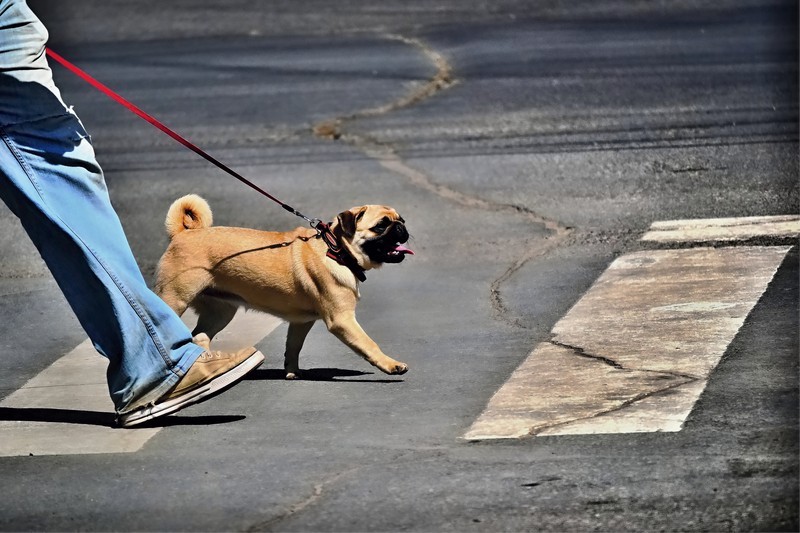
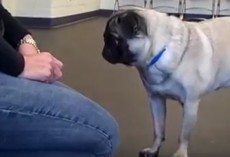
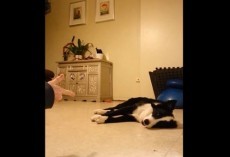





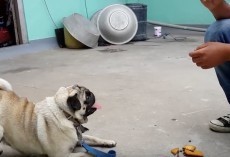

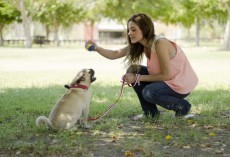
Marissa Guerra
- Edit
@[1116705617:2048:Pinky Sanciangco]
Doris Rosa Bourdier
- Edit
Harness please